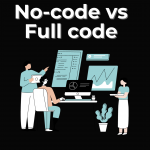In the ever-evolving landscape of technology, the way we develop applications has undergone a significant transformation. Traditional software development processes, characterized by intricate coding and lengthy development cycles, are gradually giving way to more streamlined and efficient methods. One such groundbreaking approach that has gained immense traction is Low-Code Development. This innovative technology has not only expedited the application development process but has also democratized software development, allowing individuals with diverse backgrounds to participate in creating robust applications. In this article, we will delve into a comprehensive forecast analysis of low-code development Technologies, exploring the current trends, potential challenges, and the future landscape of this game-changing technology.
Understanding Low-Code Development
Low-code development refers to a visual approach to software development that enables developers to design applications with minimal hand-coding and instead relies on a drag-and-drop interface and pre-built components. This approach drastically reduces the complexity of traditional coding methods, allowing developers and even non-developers to create feature-rich applications swiftly. The essence of Low-Code lies in its ability to bridge the gap between the demand for software solutions and the scarcity of skilled developers, fostering a more agile and responsive software development ecosystem.
Empowering Growth Through Citizen Developers: A Low-Code Revolution
In the fast-paced digital era, businesses face a dual challenge: the demand for innovative applications and a shortage of skilled developers. However, a transformative solution has emerged in the form of citizen developers. These non-technical individuals, armed with low-code development platforms, are driving growth by becoming active contributors to the software development process. In this article, we explore how citizen developers are reshaping the business landscape and fueling growth through low-code development.
Case Study 1: Healthcare Transformation:
In the healthcare sector, citizen developers have played a pivotal role in creating applications that enhance patient care. For instance, nurses and doctors, who possess valuable insights into daily healthcare operations, use low-code platforms to design applications for patient scheduling, medication tracking, and telemedicine services. These applications streamline workflows, reduce administrative burdens, and ultimately improve the overall patient experience. Case studies highlight how citizen-led initiatives have led to significant time savings, allowing healthcare professionals to focus more on patient care.
Case Study 2: Educational Innovation:
Educational institutions have embraced the concept of citizen developers to foster innovation in learning environments. Teachers, often with limited coding skills, are using low-code platforms to develop interactive educational apps, customized quizzes, and student progress trackers. These applications cater to diverse learning styles, making education more engaging and effective. Through these initiatives, schools have reported increased student engagement, improved academic performance, and a more personalized approach to learning.
Case Study 3: Streamlining Financial Processes:
In the finance sector, citizen developers have been instrumental in simplifying complex financial processes. Employees with expertise in finance but limited programming knowledge are utilizing low-code platforms to create applications for budgeting, expense tracking, and financial analysis. These applications enable organizations to optimize their financial strategies, reduce costs, and enhance decision-making. Case studies illustrate how citizen-led financial applications have led to improved financial stability, efficient resource allocation, and increased profitability.
Future Outlook:
AI-driven Assistance for Citizen Developers:
The future of citizen-led development will likely be shaped by advancements in artificial intelligence. AI-driven tools and assistants will provide real-time suggestions, automate repetitive tasks, and offer intelligent insights to citizen developers. These AI-powered features will enhance the development process, making it more efficient and accessible. For example, AI algorithms can analyze user input and provide suggestions for optimal application design, significantly reducing the learning curve for citizen developers.
Collaborative Platforms and Knowledge Sharing:
Collaborative platforms specifically designed for citizen developers will become more prevalent. These platforms will facilitate knowledge sharing, collaboration, and peer-to-peer support among non-technical individuals. Online communities and forums will enable citizen developers to learn from each other, share best practices, and collaborate on projects. Such collaborative environments will foster a sense of community and empower citizen developers to tackle more complex challenges collectively.
Industry-Specific Innovations:
Different industries will witness tailored innovations led by citizen developers. For instance, in manufacturing, employees with deep knowledge of production processes will develop applications for inventory management, supply chain optimization, and predictive maintenance. In the retail sector, store managers and sales associates will create applications to enhance customer experiences, optimize product placement, and track sales trends. These industry-specific innovations will result in highly customized solutions that address the unique challenges faced by different sectors.
The 75% Paradigm Shift with Low-Code Mastery
In the ever-evolving landscape of technology, a profound shift is occurring in the way applications are created. The rise of low-code development platforms is reshaping the software industry, promising a future where 75% of applications will be built on these innovative technologies. This transformation marks a significant departure from traditional coding methods and brings forth a wave of change that empowers businesses and individuals alike.
The prediction that 75% of applications will be built on low code paints a vivid picture of the future of software development. It envisions a world where creativity and innovation are not limited by technical expertise. Instead, anyone with a vision can actively participate in shaping the digital landscape. Businesses, both large and small, will leverage low-code platforms to create tailored solutions, automate processes, and enhance customer experiences.
The low-code revolution signifies more than just a change in development methodologies; it represents a paradigm shift in how we approach problem-solving in the digital age. As businesses embrace the simplicity, efficiency, and accessibility of low-code development, they are paving the way for a future where innovation knows no bounds. The 75% prediction is not just a statistic; it’s a testament to the limitless possibilities that low-code technologies bring to the world of applications. As we step into this future, one thing is certain: the low-code revolution is here to stay, transforming ideas into applications at an unprecedented pace and scale.
Hyperautomation & Low-Code: Business Growth Fusion
In the dynamic sphere of modern business, staying ahead means embracing cutting-edge technologies. Among the most transformative innovations are hyperautomation and low-code development. Individually, they revolutionize processes; together, they redefine possibilities. This article explores the symbiotic relationship between hyper automation and low-code development and its role in propelling businesses to new heights.
Understanding Hyperautomation and Low-Code Development:
Hyperautomation, the amalgamation of artificial intelligence (AI) and machine learning (ML) with automation tools forms the backbone of modern enterprises. It intelligently orchestrates complex processes, promising enhanced efficiency and informed decision-making. Low-code development, on the other hand, simplifies app development through intuitive visual interfaces, enabling rapid prototyping and deployment.
The Interconnected World of Hyperautomation and Low-Code:
At the heart of this synergy lies the seamless integration of hyper-automation tools with low-code platforms. Hyperautomation optimizes workflows by automating intricate tasks like data entry and approvals. When coupled with low-code flexibility, businesses can swiftly create customized applications tailored precisely to their workflow needs, fostering agility and adaptability.
Streamlining Workflows and Processes:
Hyperautomation excels in streamlining workflows, removing bottlenecks, and reducing human error. Low-code development complements this by empowering businesses to swiftly translate optimized workflows into functional applications. The result is a harmonious marriage of efficiency and innovation, enhancing productivity and customer satisfaction.
Enhancing Decision-Making with Intelligent Automation:
The integration of AI-driven hyper-automation tools with low-code platforms enables businesses to glean actionable insights from vast datasets. These insights are transformed into intuitive dashboards through low code, ensuring decision-makers have real-time, data-backed information at their fingertips. Informed decisions become the cornerstone of business strategies, driving growth and competitive advantage.
Rapid Prototyping and Iterative Development:
Low-code development allows for the rapid creation of prototypes. When fused with hyper-automation, these prototypes are refined iteratively, ensuring they align seamlessly with evolving business needs. This dynamic approach accelerates development cycles, allowing businesses to respond promptly to market demands and stay ahead of the curve.
Empowering Citizen Developers:
The synergy between hyperautomation and low-code development democratizes innovation. Citizen developers, individuals within organizations with limited coding expertise, can harness the power of these technologies. Hyperautomation equips them with advanced automation capabilities, while low-code platforms provide an accessible canvas to bring their ideas to life. This democratization of tech fosters a culture of innovation at all levels of an organization.
Security and Compliance:
One of the critical concerns in automation is security. Hyperautomation and low-code development address these concerns comprehensively. Through stringent security protocols and compliance measures, businesses can confidently navigate the digital landscape. This secure environment encourages innovation, ensuring businesses can harness the full potential of these technologies without compromising data integrity.
Real-Life Success Stories:
Numerous businesses have leveraged the synergistic prowess of hyper-automation and low-code development to achieve remarkable growth. Case studies highlight their journeys, shedding light on the transformative impact of this partnership. From streamlined operations to enhanced customer experiences, these success stories underline the tangible benefits of this collaboration.
Future Trends and Innovations:
Looking forward, the future of business automation is incredibly promising. AI-driven low-code platforms and intelligent hyper-automation solutions are on the horizon. These innovations will further blur the lines between human and machine capabilities, opening new avenues for creativity and problem-solving. Businesses embracing these trends will be at the forefront of innovation, driving the evolution of industries.
FAQs
How Have Low-Code Development Technologies Evolved Over the Years?
Low-code development technologies have evolved from simple drag-and-drop interfaces to sophisticated platforms with advanced capabilities. Early versions focused on basic application creation, but modern low-code platforms offer features like AI integration, real-time collaboration, and extensive customization options.
What Industries Benefit the Most from Low-Code Solutions?
Industries such as healthcare, finance, manufacturing, and retail benefit significantly from low-code solutions. In healthcare, low-code platforms streamline patient management systems. Financial institutions use them for secure transactional applications.
What Challenges Do Businesses Face When Implementing Low-Code Solutions?
Common challenges include security concerns, integration issues with existing systems, and the need for skilled developers to handle complex functionalities. Businesses must address these challenges by adopting robust security measures.
What Is the Future Outlook for Low-Code Development Technologies?
The future of low-code development technologies looks promising. Experts predict continuous growth, with increased focus on AI-driven automation, IoT integration, and enhanced collaboration features. As businesses demand more flexibility and speed, low-code platforms are expected to evolve.
How Can Low-Code Development Improve Workflow Efficiency?
Low-code platforms enhance workflow efficiency by automating repetitive tasks, reducing manual errors, and accelerating development cycles. Businesses can design intuitive user interfaces, automate approval processes, and integrate data seamlessly.
How Do Low-Code Platforms Facilitate Collaboration Between IT and Business Teams?
Low-code platforms act as a bridge between IT professionals and non-technical business users. Business teams can actively participate in the application development process by providing input, testing prototypes, and suggesting improvements. This collaborative approach ensures that applications align closely with business needs and goals.
Can Low-Code Solutions Integrate with Existing Legacy Systems?
Yes, most low-code platforms offer robust integration capabilities, allowing seamless connection with existing legacy systems, databases, and third-party applications. Through APIs and connectors, businesses can ensure smooth data flow between new low-code applications and their established IT infrastructure.























